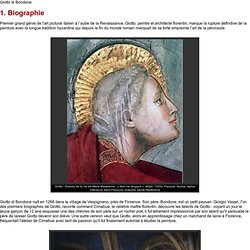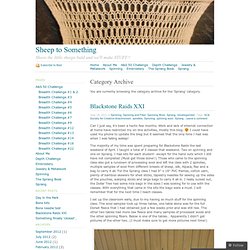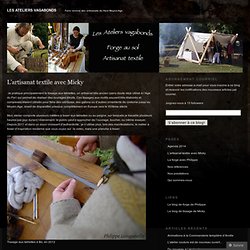

Giotto di Bondone. Giotto di Bondone Premier grand génie de l'art pictural italien à l’aube de la Renaissance, Giotto, peintre et architecte florentin, marque la rupture définitive de la peinture avec la longue tradition byzantine qui depuis la fin du monde romain marquait de sa forte empreinte l’art de la péninsule.

Giotto di Bondone naît en 1266 dans le village de Vespignano, près de Florence. Son père, Bondone, est un petit paysan. Giorgio Vasari, l'un des premiers biographes de Giotto, raconte comment Cimabue, le célèbre maître florentin, découvre les talents de Giotto : voyant un jour le jeune garçon de 12 ans esquisser une des chèvres de son père sur un rocher plat, il fut tellement impressionné par son talent qu'il persuade le père de laisser Giotto devenir son élève. Une autre version veut que Giotto, alors en apprentissage chez un marchand de laine à Florence, fréquentait l'atelier de Cimabue avec tant de passion qu'il fut finalement autorisé à étudier la peinture. 2.1. 2.1.1. 2.1.2.
Headdresses. Medieval Women's Head-dresses TEMPLERS & BOSSES - HORNED HEADDRESSES - CRESPINES & CAULS - CYLINDER CAULS PADDED ROLLS - HEART-SHAPED HEADDRESSES A woman's outfit was not complete without headwear of some kind.

A woman's activity and function would have determined what kind of headwear was required. Many of these were constructed from fabric but some were built on a wire base or used metal in their construction This page takes a brief look at the most popular forms of medieval head-dresses. Templers and Bosses Sometimes also known as fretts or bosses, templars were fashionable among the upper classes during the 14th century. Chaucer, in his prologue to the Legend of Good Women, notes 'A frett of goold sche hadde next hyre her' indicating that these might be made of gold or gold thread. BOSSES: Decorative cauls of net-work or linen covering the thick coils of plaited hair, generally artificially enlarged and arranged on each side of the head above the temples. Glossary of English Hairstyles and Headdress: Anglo-Saxon (600 – 1154): Simple Veils, Head-tires, Combs, and Pin During this time the head was always covered with no hair showing, although it was usually braided elaborately underneath the veil.

Veils- made of light-weight fabric like silk, cambric, or fine linen. They were usually rectangular lengths with a hole cut in the middle for putting the head through. Head-tires- circlets of gold that could be worn by any Saxon of rank at this time. The circlets could be made of other material, and the veil could be worn under or over. Norman (1066-1154): Couvre-chef, hair uncovered, and extreme length Couvre-chef- a new name for the head-rail after the Norman invasion. Hair uncovered- by 1125 women began to appear in public with their hair uncovered, usually worn parted down the middle and plaited in various ways Plantagenet (1154-1399): Wimple, Barbette, Fillet and Crespine Barbette- supposedly introduced by Eleanor of Aquitaine, was a band of linen encircling the face and pinned into place.
Sprang « Sheep to Something. Can I just say, it’s been a hectic few months.

Work and lack of internet connection at home have restricted my on-line activities, mostly this blog. :-P I could have used my phone to update the blog but it seemed that the only time I had was when I was falling asleep! The majority of my time was spent preparing for Blackstone Raids the last weekend of April.
14th Century - Historical Needlework Resources. Gefren. Tagebuch aus der alten Wikinger-Siedlung Haithabu / Hedeby in Schleswig-Holstein. An diesen Wochenende zeigte Saskia Sobbe im Haus Nr. 3 [Haus der Händler] das Brettchenweben.

Unabhängig von einem Webstuhl oder -Rahmen läßt sich damit textile Bänder herstellen. Im Haus lagen einige von ihr gewebten Borte (oder auch Bordüre genannt) aus. Vor dem Haus konnte man ihr beim Brettchenweben zusehen und auch Fragen stellen.Sie war mehrmals von Besuchern regelrecht umlagert. Das Wetter spielte auch mit, viel Sonne und es war recht mild. Saskia Sobbe hier mit Reinhard vom Museum.
Hier demonstriert Reinhard, wie man bei den Wikinger Feuer machte. Der Verkaufsstand von Vikingr-Kontor.
Fournisseur. Histoirejeannedarcodieuxconnardt.jpg (Image JPEG, 800x11113 pixels) Broderie. L’atelier de Micky: tissage « Les ateliers vagabonds. Je pratique principalement le tissage aux tablettes, un artisanat très ancien (sans doute déjà utilisé à l’Age du Fer) qui permet de réaliser des ouvrages étroits.

Ces tissages aux motifs souvent très élaborés et complexes étaient utilisés pour faire des ceintures, des galons ou d’autres ornements de costume jusqu’au Moyen-Age, avant de disparaître presque complètement en Europe vers le XVIème siècle. Mon atelier comporte plusieurs métiers à tisser aux tablettes ou au peigne, sur lesquels je travaille plusieurs heures par jour durant l’évenement: le public peut s’approcher de l’ouvrage, toucher, ou même essayer.
Depuis 2011 et dans un souci croissant d’authenticité, je n’utilise plus, lors des manifestations, le métier à tisser d’inspiration moderne que vous voyez sur la vidéo, mais une planche à tisser: Les Ruistres sans terre. Le blog de Audeline de Bellecour. Le blog de Luis de Casal. L'atelier de Mathilde.